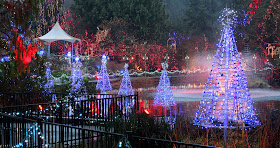After visiting the
U'Mista Cultural Centre in Alert Bay, a moving tribute to the Kwakwak'wakw people and the Potlatch, we stepped out into the sunlight and viewed a vacant lot adjacent to the
Centre.

This was the site of St. Michael's Indian Residential School, sometimes referred to as the Alert Bay Residential School, and often as "St. Mike's." It was built in 1929 as a regional school for Aboriginal children from North Vancouver Island and the province's north coast, including children from Bella Bella, Bella Coola, the Nisga’a territories and Haida Gwaii.
In fact, these children were forcibly taken from their parents, prohibited from speaking their own languages, kept away from their families for years and inculcated with Anglo-European beliefs. That the school was largely self-sufficient with its own farm, cattle, water and electric plant, was largely due to the free labour pool at its disposal.
"Almighty God for what has been accomplished: for a race of people brought in the shortest period of time known in history from the most debasing savagery to citizenship both in the Kingdom of our God and in his God-blessed Dominion of Canada."
Published in 1934
by the Indian Residential School Commission
of the Missionary Society of the Church of English, in thanks and appreciation for St. Michael's in Alert Bay

Thankfully, St. Michael's closed in 1975. The 'Namgis First Nation was given control of the building and it was used for several purposes. In February of 2015, First Nations, church leaders, former students and politicians attended a healing ceremony hosted by the 'Namgis First Nation to mark the demolition of the building. In May of the same year, 'Namgis had a blessing of the Land ceremony.
There's something strange about standing here, to think about fifty years and more of an "education" system designed to destroy a people. It was such a large building, with classrooms, offices and quarters for 200 students. It was a structure that dominated the town itself, again perhaps part of the design to eliminate an entire culture.
This empty lot isn't empty at all; it's full of stories of pain, fear and anger, that continues to cross generations to this day.
Empty lot photo by Jeem (others: archival photos).
Copyright 2017 by Jim Murray.






















































